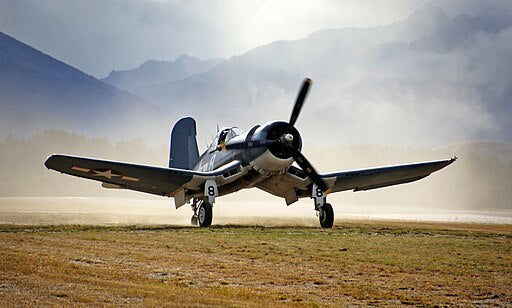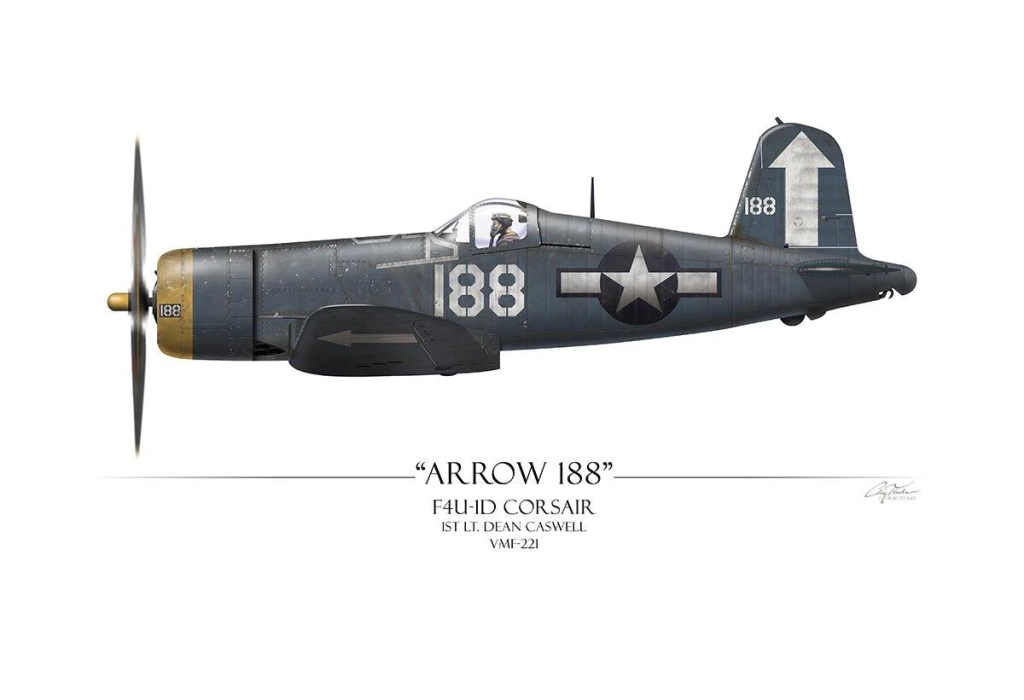In aviation history, few aircraft possess the distinctive and memorable profile of the Vought F4U Corsair. Known to aviation enthusiasts and wartime pilots as the “Bent-Wing Bird,” the Corsair’s iconic inverted gull-wing design has fascinated, puzzled, and captivated onlookers for decades.
Far from being a mere aesthetic quirk, this unique wing structure was a union of form and function, a brilliant solution to the demanding aerodynamic and operational requirements of its time. We will explore the genesis, design, and operational significance of the Corsair’s famous bent wings.
The Birth of a Warbird: The Need for Speed and Power
As World War II loomed, the aviation industry faced immense pressure to deliver faster, more powerful fighter planes. The United States Navy required an aircraft that could outperform enemy planes in the Pacific Theater while withstanding the rigors of carrier operations.
The Vought F4U Corsair was born out of this need—a powerful, carrier-based fighter designed to dominate the skies.

Enter the Pratt & Whitney R-2800: Power Meets Engineering Challenges
At the heart of the Corsair was the Pratt & Whitney R-2800 Double Wasp engine, a massive 18-cylinder, air-cooled radial engine capable of producing over 2,000 horsepower. This powerhouse enabled the Corsair to achieve speeds exceeding 400 mph, making it one of the fastest fighter planes of its time.
However, the engine’s immense power also posed significant engineering challenges, particularly regarding the propeller size required to harness this power effectively.
The Propeller Dilemma: A Need for Larger Landing Gear
The solution to this power problem was a massive 13-foot 4-inch diameter propeller, allowing Corsair to convert engine power into thrust efficiently.
However, this large propeller created a new problem: the landing gear needed to be significantly longer to prevent the propeller tips from striking the ground during takeoff or landing. Long landing gear, however, would be fragile and unsuited to the harsh, high-impact landings on aircraft carrier decks.
The Ingenious Solution: The Inverted Gull Wing Design
Vought’s engineers faced a significant challenge: designing an aircraft that could accommodate a large propeller while maintaining short, sturdy landing gear suitable for carrier operations. The solution came in the form of the Corsair’s now-iconic inverted gull wing design.

Why the Gull Wing? Practical Ground Clearance
With its downward bend near the fuselage and upward angle at the wingtips, the gull wing design allowed engineers to shorten the landing gear without sacrificing ground clearance for the propeller.
This design meant that the landing gear could be both short and strong, capable of withstanding the brutal impacts of carrier landings while ensuring that the propeller was safely clear of the ground.
Beyond Ground Clearance: Aerodynamic Advantages
While the gull wing design initially solved the ground clearance problem, it soon became apparent that this configuration offered additional aerodynamic benefits.
The inverted gull wing improved the aircraft’s center of gravity, lending stability during flight, particularly during the turbulent approach to a carrier deck. This stability was crucial for pilots, as carrier landings were notoriously challenging and dangerous.
Wingtip Vortices: Reducing Aerodynamic Drag
The upward angle of the wingtips beyond the central downward bend also played a critical role in reducing wingtip vortices—whirlwinds of air that form at the wingtips during flight.
By minimizing these vortices, the Corsair’s gull-wing design improved the aircraft’s overall aerodynamic efficiency, allowing it to maintain higher speeds and better fuel economy.

Operational Mastery: The Corsair’s Carrier Landing Capabilities
Carrier landings are among the most challenging maneuvers a pilot can perform. The Corsair’s initial design presented some difficulties in visibility during landing approaches, as the long nose of the aircraft could obscure the pilot’s view of the deck.
However, these challenges were eventually overcome through pilot training and minor design adjustments. The robust landing gear, made possible by the gull-wing design, ensured that the Corsair could handle the intense stresses of carrier landings more effectively than many of its contemporaries.
The Whistling Death: A Fearsome Reputation
The Corsair quickly earned a fearsome reputation among allies and adversaries in the Pacific Theater. Its distinctive engine sound, often described as a “whistling death,” struck fear into the hearts of enemy pilots and ground troops alike.
The combination of speed, power, and agility made the Corsair a formidable opponent in dogfights, while its rugged construction allowed it to withstand significant damage and keep flying.
The Corsair in Combat: A Warbird Like No Other
The Corsair’s combat performance further cemented its legendary status. It was particularly effective in the hands of skilled pilots who could exploit its strengths and mitigate its weaknesses.
The aircraft’s ability to deliver devastating firepower, speed, and maneuverability made it a key player in several pivotal battles in the Pacific Theater.
A Legacy of Innovation: The Corsair’s Enduring Influence
The Corsair’s bent wings are more than just a distinctive design feature—they are a testament to the ingenuity and innovation of Vought’s engineers.
The aircraft’s ability to overcome significant engineering challenges and deliver outstanding performance under the harshest conditions is a testament to the creativity and determination of the people who designed and built it.

From Carrier to Airshow: The Corsair’s Post-War Life
After World War II, the Corsair continued to serve in various roles, including in the Korean War. Its rugged design and powerful engine made it well-suited for ground attack missions, where it could deliver precision strikes against enemy targets.
Even after its military service ended, the Corsair remained popular among civilian pilots and aviation enthusiasts, often appearing in airshows and museums worldwide.
The Bent-Wing Bird Today: A Symbol of Excellence
Today, the Corsair is celebrated for its combat prowess and its role as a symbol of engineering excellence. The aircraft’s distinctive profile and storied history make it a favorite among historians, model builders, and aviation enthusiasts.
Its enduring legacy inspires new generations of engineers and pilots, reminding us of the incredible feats that can be achieved when form and function are seamlessly integrated.
A Design That Soared: The Corsair’s Place in Aviation History
In aviation history, the Vought F4U Corsair holds a special place. Its unique design, characterized by the iconic inverted gull wing, represents a perfect blend of form and function.
The Corsair’s ability to meet the demanding requirements of carrier operations while delivering superior performance in combat made it one of World War II’s most effective fighter planes.
The Bent-Wing Bird’s Cultural Impact: Beyond the Battlefield
Beyond its military accomplishments, the Corsair has left a lasting impact on popular culture. From its appearances in movies and television shows to its presence in countless museums and airshows, the Corsair remains a symbol of American ingenuity and resilience.
The aircraft’s distinctive design has become synonymous with the spirit of innovation that defined the World War II era.
The Corsair’s Impact on Modern Aviation Design
The lessons learned from the Corsair’s design continue to influence modern aviation. The principles of aerodynamics, structural integrity, and functional design that guided the development of the Corsair are still relevant today.
Modern aircraft designers often look to historical examples like the Corsair for inspiration and guidance in overcoming new challenges.

A Final Tribute: Honoring the Bent-Wing Bird
As we reflect on the Corsair’s place in history, it’s important to honor the men and women who designed, built, and flew this incredible aircraft. The Corsair was more than just a machine—it was a symbol of hope, determination, and the relentless pursuit of excellence.
The “Bent-Wing Bird” remains a testament to what can be achieved when innovation meets necessity, and it continues to inspire all who encounter its remarkable story.
The Enduring Legacy of the Corsair: A Warbird for the Ages
The Vought F4U Corsair’s legacy endures as a warbird and a beacon of engineering excellence. Its distinctive design, born out of necessity, has become a symbol of American ingenuity and determination. The Corsair’s story is one of overcoming challenges, pushing the boundaries of what was possible, and achieving greatness in the face of adversity.
As we look to the future of aviation, the lessons of the Corsair remain as relevant as ever, reminding us that with creativity and determination, even the most formidable challenges can be turned into opportunities for greatness.
For more insights into the F4U Corsair and other important military aircraft, visit Aces In Action. Here, you’ll find an amazing piece of artwork by Craig Tinder titled “Arrow 188,” which illustrates a profile of the Corsair flown by Lt. Dean Caswell.
Arrow 188 F4U Corsair Aviation Art Print – Profile by Craig Tinder
1st Lt. Dean Caswell entered service in 1943 upon graduation from flight school in Pensacola, Florida. He was immediately assigned to the U.S. Marine Corp with VMF-221 . Assigned to the U.S.S. Bunker Hill of Task Force 58, VF-84 took part in the invasion of Iwo Jima as well as raids on Tokyo and other mainland Japanese targets. VF-84 also took part in the discovery and demise of the Japanese Battleship “Yamato”, the largest warship in the world.






Share:
Aerial Tactics of WWII: Analyzing 1st Lt. Ploetz’s Strategy and Maneuvers
A Duel in the Skies: The Ingenious Maneuver of Bindseil’s FW-190